Beyond The CC0 — MetaIP
Beyond The CC0 — Metaverse Native Decentralized Copyright Agreement Business Model
1. The New HotSpot For NFTs
On August 1, 2022, the famous crypto artist XCOPY announced “all in CC0” (in March 2022, the encrypted art NFT “Death Dip” created by XCOPY was sold at SuperRare for 1000ETH), indicating that all his works will be open CC0.
On August 5, 2022, Kevin Rose, the founder of the famous NFT project Moonbirds, publicly announced on Twitter that Moonbirds NFT will be converted to “CC0 mode”, and MoonbirdsDAO will be established, which will be opened one after another in two pioneering projects in the crypto industry. After CC0, it is necessary to understand what CC0 is and the business authorization model of NFT.
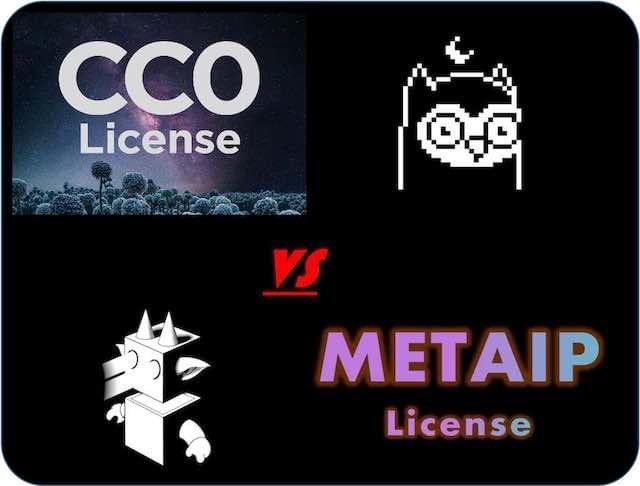
“CC” is the abbreviation of Creative Commons (Creative Commons), and “0” means no copyright. Therefore, CC0 NFT generally refers to NFT without copyright restrictions. The creator gives up all the copyrights condensed in the NFT work and contributes it to the public domain. No one needs to buy or hold the NFT, and the outside world can freely use the NFT work for commercial or non-commercial purposes and re-creation.
Moonbirds’ move undoubtedly opened up space for the re-creation of its own NFTs, but its sudden openness caused dissatisfaction among the NFT collectors and holders. First, this idea did not seek advice from the community, and it was decided by the developer, which violated the community spirit of the blockchain; second, many users initially chose to buy Moonbirds NFT, originally counting on the developer to provide the NFT through operation. NFT asset empowerment.
Although users don’t quite understand it, entrepreneurs and capital in the industry seem to be forming a trend of advocating the open copyright of NFTs, which is evident from the recent attention to CC0 NFTs in the crypto field.。
2. CC0 Reloaded
1. What is CC0
Regardless of whether the copyright owner cares about its copyright, the copyright laws of various countries will basically give works copyright protection at the legal level by default. In order to circumvent this rigid law, a creative commons organization, CC (Creative Commons), was established at Stanford University in the United States in 2001 to “face the growing restrictions of copyright law and promote the sharing of knowledge in a participatory culture”. For this purpose, by providing a series of standardized CC protocols (Creative Commons licenses) and tools to enter the public domain (public domain tools), it helps copyright owners to better share knowledge and creativity.
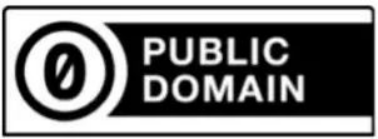
(CC0 protocol icon)
Copyright owners can declare that they only reserve the Part of the copyright or related rights in a work to allow the public to freely use the work under certain conditions and uses. This protocol can be applied to text, pictures, music, and software.
Different from the above 6 CC agreements, the CC0 agreement “Creative Commons Zero (Free Creative Commons)” represents the copyright owner through legal text declarations, to the maximum extent permitted by law, and without violating any relevant laws. , giving up all copyrights of the work in the legal sense and making the work enter the public domain, which will allow anyone to freely use the work for commercial use or secondary creation. It embodies “No Rights Reserved”, as opposed to the “ALL Rights Reserved” disclaimer attached to the footer of every web page.
2. Analysis of The Judicial Practice of CC0
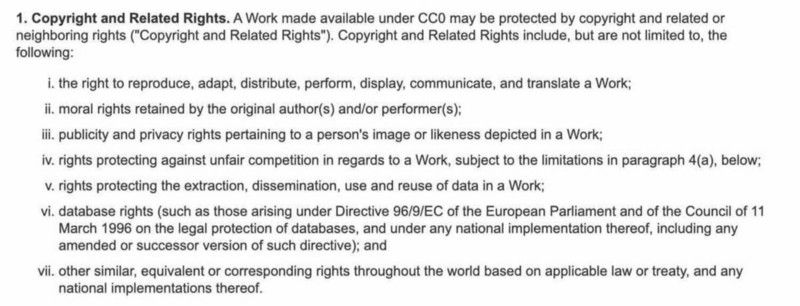
(From Creative Commons CC0 1.0 Common)
Taking China as an example, combined with the judicial practice of the “Copyright Law”, in the legal context of mainland China, neither the project party nor the Holder can of course regard the CC0 agreement as the copyright owner has completely waived all copyright rights. The CC0 agreement is only an internationally accepted declaration tool, and its effect can be different in different jurisdictions. It is also mentioned in its legal text that “To the fullest extent permitted by law, and without violating any relevant law, the declarant hereby publicly, completely, permanently, irrevocably and unconditionally waives and concedes waive all copyright, related rights and any related known or unknown (including existing and future) claims or claims (“Waiver”) in the Work.
That is to say, the exercise of the CC0 agreement is based on the premise of not violating the relevant copyright laws. Taking mainland China as an example, because the copyright law only stipulates that the copyright owner can transfer the property rights in the copyright, in fact, the transfer of personal rights is not allowed. Therefore, the CC0 agreement in mainland China cannot achieve the legal effect of giving up the personal rights in the copyright.
It may be clear to everyone that I wrote this. The so-called CC0 means that the copyright owner uses a general agreement to tell everyone that the author has given up the copyright, and the copyright given up by the author has entered the public domain, and the owner Can be used freely. However, CC0 also clearly states that the copyright owner’s trademark rights or patent rights, or rights that have not yet been mentioned, do not mean that they must be abandoned and enter the public domain with the statement of CC0. This requires great attention, and is one of the reasons why Kevin Rose will set up Moonbirds DAO in the future.

(Kevin Rose Twitter)
3. CC0 Reloaded
Why NFT Projects Start To Try CC0 Now?
Some people believe that NFTs began to turn to CC0, not only because of the sudden success of the case, but because of the current crypto market environment. The NFT market, which is mainly oriented to the C-side, is beginning to feel the cold of the bear market, the new funds entering the crypto market are decreasing, the transaction volume and user participation in the NFT market are declining, the bonus period is ending, and new projects are also caught in the “repeat wheel” The predicament is nothing new.
If NFT projects want to get a share of the battle in the stock market, they need to change the operational thinking of selling NFTs. One of the advantages of NFT is that it is programmable. With such an attribute, it is far better to let everyone stand on the shoulders of giants and brainstorm ideas behind closed doors. The open copyright model without purchase may lose NFT sales, but it is a cheap and quick shortcut to try to activate external creativity to bring new opportunities to the project through open copyright CC0, and we are seeing MoonBirds trying this route. And successfully attracted the attention of the currently silent market.
3. List of NFT Business Authorization Models
At present, the mainstream commercial authorizations in the NFT market are divided into the following three types, which are arranged from top to bottom in order of openness:
(1)CC0 Project — Mfers: Anyone Can Use Anything
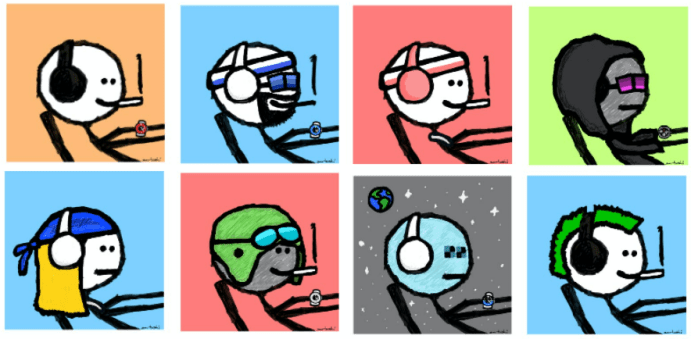
Mfers is a PFP (avatar type) 10k project hand-painted by art creator Sartoshi, and its style is a minimalist stickman image. Sartoshi didn’t mention CC0 too much, and didn’t make any fancy statement. He only sent the following paragraph when mint, which is very Mfer.

After the release, Sartoshi fiddled with the community for a while and let the community do what they wanted. The Mfers community thrived under the leadership of holders and community members who owned their own Mfers, but no one owned the IP. Sartoshi wrote in his “What are Mfers”: “In the Mfers world that Ta envisions, we are all Mfers.” This simple and straightforward slogan caters to the value attitude resonated by all living beings in the modern Internet age, plus Open the mechanism of CC0, so that this resonance is not limited to holders and community members, but radiates to the entire Web3 world.
(2)Limited commercial licensing project — BAYC : Holder has the right to use it for commercial
Needless to say, BAYC is famous. In recent years, many domestic brands have purchased BAYC avatars for their own brand marketing and commercial promotion. For example, sports brand Li Ning purchased the avatar #4102 of the BAYC series. The joint name of sportswear peripherals and the TOHO digital collection platform purchased the #5513 avatar and launched the “Chinese version” of the boring ape series digital collection BATC, etc.
The above business practices are based on the commercial license terms on BAYC’s official website: “Commercial use: On the premise that you continue to abide by these terms, Yuga Labs LLC grants you an unlimited license to use, reproduce and display the purchased collections worldwide, and create derivatives (“commercial use”) based on the collection.”

(BAYC official website)
Don’t underestimate the simple licensing terms above. These terms have released huge space for the holder’s subsequent commercial development. The holder can use the well-known image IP of Bored Ape to engage in many commercial activities. It is a win-win for both the holder and the boring ape IP itself. lift. By issuing NFT and open copyright sharing, Boring Ape IP allows everyone who owns Boring Ape NFT to help in the derivation and value realization of IP, which greatly improves the value of IP development speed.
(3)No commercial license project — CryptoPunk: No commercial license
The CryptoPunks series of punk pixel avatars created by Larva Labs has always been a leading project in the NFT market. Encryption enthusiasts snapped up this series of NFTs and set them as personal social avatars to flaunt their own encryption community, which means, Holders of CryptoPunks have ownership of the NFT.

When it was hot, few people thought about “whether I can recreate or commercialize CryptoPunks”. Until the end of 2021, Larva Labs requested OpenSea to remove multiple derivative projects in the name of “copyright infringement”. Among them, the most famous “infringing” derivative NFT project is CryptoPhunks. In terms of naming, this project has one more “h” than CryptoPunks. The visual content of the avatar is to reverse the original pixel avatars from left to right, and the project as a whole looks like the original copycat.
Larva Labs’ delisting request was finally met by OpenSea, but it also left a question: What exactly does the so-called copyright of CryptoPunks include? The project has never been made clear to the public before. It seems that the copyright is owned and used by the publisher by default, and holders do not have the right to use it commercially.
In August 2021, Larva Labs signed an agency agreement with the Hollywood agency UTA (United Talent Agency). This cooperation revealed that CryptoPunks has been seeking opportunities for copyright cooperation with film, TV, video games and other entertainment platforms in an attempt to gain revenue from the B-side. There is speculation that this is the reason why Larva Labs has been reluctant to grant similar commercial licenses to NFT holders.
This incident really caused NFT collectors to notice the CryptoPunks copyright issue, and provoked the anger of CryptoPunks holders: “We invested in your NFT, you have made money from me, but you don’t seem to plan to share the return with me In part, this is not in line with the Web3 spirit of “value returns to the user”.
Until March 2022, Yuga Labs, the developer of the boring ape, acquired CryptoPunks and announced the opening of the commercial copyright of the NFT series. The copyright of the CryptoPunk series is finally clear.
4. CC0 Turn Left, BAYC Turn Right
1. Questions About CC0
Moonbirds did not clarify the copyright situation in the early days of its establishment, until August 5, 2022, the co-founder of the project Kevin Rose publicly announced that Moonbirds and Moonbirds Oddities series NFTs will be converted into projects with CC0 license, supporting anyone in the public world to create and spawn new projects.
Moonbirds, which turned to CC0 halfway, caused dissatisfaction among NFT Holder users.
Some people said that the original purchase of Moonbirds NFT at a high premium was because they valued the strength of the PROOF company behind them, and expected the team to empower “Moonbirds” in the future. Now switching to CC0 will dilute the IP value. There are also speculations that contributing the project copyright to the public domain may mean the withdrawal of the PROOF team, the team halo is no longer, and the value of Moonbirds needs to be re-evaluated, so who will protect the interests of the users who chose to buy because of the team background?
Some people questioned that the CC0 turn of the moonbird is essentially a cheap attempt to rub the current hotspot. For users’ questions, PROOF officials have not yet responded.
2. BAYC Copyright Model Trap
It needs to be emphasized that although the BAYC copyright is open to Holder holders, there is an obvious limitation: it is only open to Holder to create and develop derivatives based on the NFT itself purchased by itself, and does not share and open the BAYC brand name and Identifies usage rights.
For example, China Lining purchased BAYC #4102 NFT, China Lining can only use the image of #4102 Boring Ape, and can print #4102 Boring Ape image on T-shirts, hats, shoes for commercial use, but cannot change or recreate the ape image. China Li Ning can only mark the number “BAYC#4102” or “#4102” on the clothes, and cannot directly use the brand logo and name of the BAYC series.
It can be seen that the holder of BAYC NFT can only develop derivatives based on the purchased image of a boring ape, and the IP attribute of NFT is not open to the public, which limits more use scenarios of BAYC, such as in the metaverse with The interaction of other NFTs, and the interests of the developer and Holder are not consistent. As a buyer, Holder cannot enjoy the value-added rights and interests of the overall IP of the NFT. If such a demand breaks out in the market, it will require NFT developers to open up more rights attributes.
BAYCs are more like a “PGC brand”, and professional project parties are responsible for output, or guide users to output NFT-related content. The official leads the development of the project line, and regularly reports the latest progress, so as to create an IP brand of NFT.
The CC0 NFT project is more like a “UGC platform”, which is led by users or outputs NFT content. The NFT project party provides basic element components or concepts, and users can build their own content according to their needs. For example, users can establish a DAO organization to jointly build the project ecology, or derive a new game or physical object based on NFT. CC0 NFT projects give up IP ownership, giving every user the opportunity to participate in the creation of this IP. At this time, NFT projects are more like an ecological incubator.
3. The Third Option?
In addition to CC0 with fully open copyright and limited open BAYCs (NFT brand name and brand logo usage rights are not open to Holders), is there a third copyright model option, which can not only give global holders enough rights to share, but also allow copyright original owner & developer has continuous motivation to innovate? We assume it is called METAIP, what will it look like?
5. The Rise of METAIP — Metaverse Original IP Copyright
Whoever seizes the throne of the future Metaverse digital culture brand influence will have the right to define and speak of popular culture and fashion brands in the future Metaverse digital world. The world’s leading digital companies have launched a silent dark battle to compete for Metaverse IP brand highland is imminent
Is there a new generation of smart contract-based digital copyright IP model that is more open than BAYC and better represents the rights and interests of holders than CC0? We searched all Metaverse IP projects on the market, and found that the Metaverse native MetaIP decentralized copyright protocol released by “DragonCapsule” is a good innovation, binding the holder’s MetaIP through the NFT global standard ERC721/ERC1155 Digital rights, and shared and opened the NFT brand name and logo usage rights to Holder, and realized the digital rights and flowable digital IP of the Metaverse IP with NFT as the carrier。
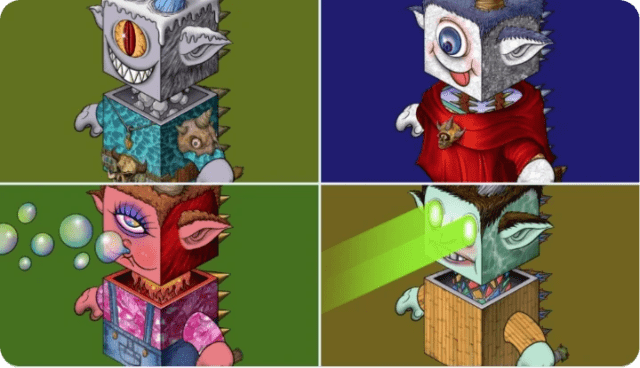
DragonCapsule applies METAIP license
If the BAYCs are in the “PGC mode”, the CC0 ( which Mfers belongs to)is the “UGC mode”, and the MetaIP( which DragonCapsule belong to )is the “PGC+UGC mode”, MetaIP has advantages of both former, MetaIP not only allows global Holders to participate in the creation of IP an the process of promotion, it also protects the driving force of developers to continuously innovate and promote the project forward. It well integrates the common interests of Holder and developers, and perfectly realizes the co-creation and sharing power based on DAO

MetaIP (Metaverse Native Decentralized Copyright Agreement ) not only opens up the purchased NFT copyright to Holder holders, but also shares and opens up the NFT brand name and logo usage rights to Holder. MetaIP realizes the right of its digital assets through the associated NFT works. It is a digital certificate for sharing its MetaIP rights and interests, and it is also a digital certificate for the DAO governance associated with the NFT brand..
DragonCapsule is the world’s first NFT brand collection that applies the METAIP Agreement. For the first time, the rights to use the brand name and logo have been opened, and rights have been shared with global nft Holders.
The combination of digital proof of rights and social identities endowed by MetaIP has brought about the comprehensive innovation of Web3.0 SocialFi, and the social value can be embodied, and IP rights can be exercised in the real world and circulated and realized in the NFT market.
MetaIP utilizes blockchain technology and NFT standards to achieve unforgeable and unique features. It is not only suitable for the confirmation of digital assets, but also makes it a perfect carrier for the Native IP digital rights and interests of the Metaverse. With the growth of MetaIP, Has unlimited room for appreciation.
MetaIP can also build a global IP collaboration and a fair and transparent digital economy sharing model through the DAO governance form, and promote the healthy and orderly development of the cross-regional cultural industry. Decentralized protocols and DAO-based emerging entities could reshape culture and everything about IP, from how IP is built to how people communicate and create communities.
6. Conclusion: Metaverses needs theirs own native copyright model
Through the above analysis, we believe that NFTs carry more than only N small pictures generated by simply piecing together elements through AI tools. It is a great fallacy to aim at NFTs as digital artworks/digital collections. In fact, it’s a smart data container that has infinite possible , Metaverse native IP copyright and IP property rights are one of its possible killer applications.
The NFT project party grants holders and community members a series of rights through various innovative IP authorization forms (including the adaptation of NFT avatars, secondary creation, derivative development, DAO identity digital certificates, etc.), which drives the secondary creation of holders and community members. , enhance the playability, narrative, and applicability of NFT projects, create strong community consensus and generate practical value, this is what the Web3 world wants to see.
The emergence of MetaIP, the native IP copyright of the Metaverse, is part of the digital development of human society and the wave of Web3.0 change. We cannot predict the scope of the change, nor how it will reshape culture. At this early stage, it is not yet known what will become the catalytic code, and these catalysts may be technology, regulation or culture. It’s also unclear whether this shift will come from an innovation in how benefits are distributed, or from the application of a decentralized paradigm powered by blockchain — but it will certainly have far-reaching implications and implications.
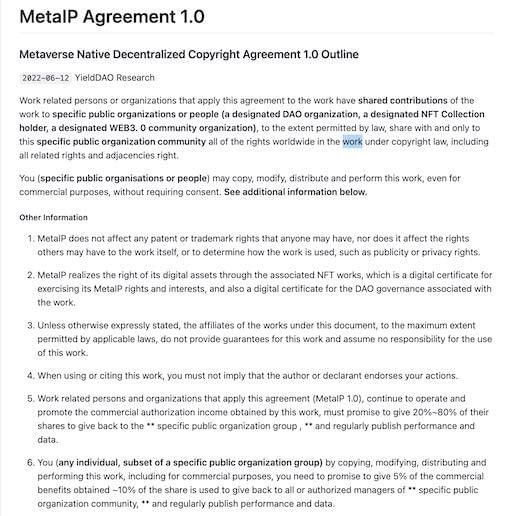
MetaIP Agreement
It is believed that in the near future, with the introduction of BAYC、CC0、MetaIP, and various innovative IP authorization models, blockchain technology and NFT will greatly improve the liquidity of IP and the efficiency of cooperation, and change the creation and derivation of traditional IP itself. Only by truly applying the technical characteristics of NFTs to practical business economies and real-world scenarios is the right way to regulate the NFT market and promote the healthy and sustainable development of the digital new economy.
Refercences:
喜欢我的作品吗?别忘了给予支持与赞赏,让我知道在创作的路上有你陪伴,一起延续这份热忱!

- 来自作者
- 相关推荐